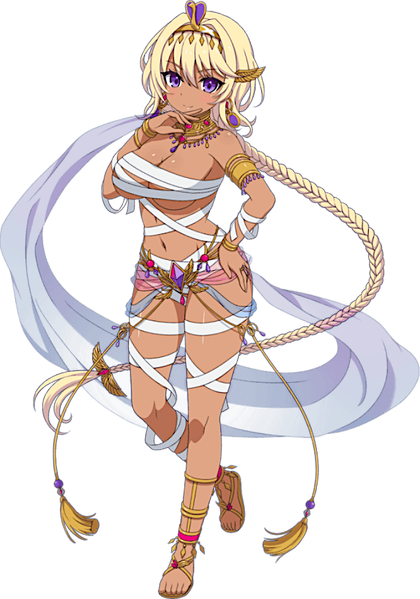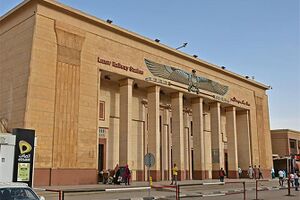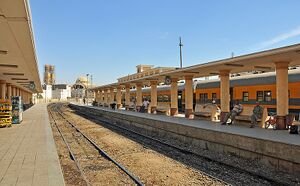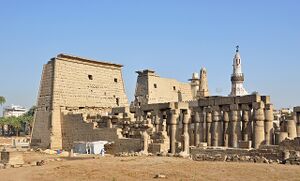Luxor
| Luxor | |||||
|---|---|---|---|---|---|
| Japanese Name | ルクソール | 
| |||
| Race | Human | ||||
| Nationality | |||||
Kyeheheh. So you're the Conductor I've heard so much about? Being royalty myself, I can tell you're the leader of this rowdy bunch.♪ And if that's who you are, you know exactly what our plans are.
Profile
Trivia
- Luxor's overall design and backstory takes influence from the ancient ruins around Luxor, known as the "world's greatest open-air museum".
- In the Mist Train Girls story, Luxor is also the last surviving human subspecies, "Children of the Sands". This race of humans completely abstained themselves from water, and are weakened significantly should they come into contact with water. In the modern era, the current human population in Iris Cloud is exclusively "Children of the Seas", these humans cannot survive without water. This is a reference to Luxor city's climate in real life, as Luxor is one of the warmest and driest cities in the entire world.
Counterpart
Egyptian National Railways (Arabic: السكك الحديدية المصرية, romanized: Al-Sikak al-Ḥadīdiyyah al-Miṣriyyah) is the national railway of Egypt and managed by the parastatal Egyptian Railway Authority (Arabic: الهيئة القومية لسكك حديد مصر, romanized: Al-Haī'ah al-Qawmiyya li-Sikak Ḥadīd Miṣr, lit. 'National Agency for Egypt's Railways'). The Egyptian railway system is the oldest railway network in Africa and the Middle East and the second oldest in the world.
The first line between Alexandria and Kafer Eassa was opened in 1854. In 2018, the system is about 5,085 km (3,160 mi) long and is operated by the Egyptian National Railways. ENR carries about 800 million passengers and 12 million tonnes of freight annually. Cairo's main Misr Station was rebuilt in 1892. The line south was extended further upriver from Assiut reaching Girga in 1892, Nag Hammadi in 1896, Qena in 1897 and Luxor and Aswan in 1898. With the railroad's completion, construction began the same year on the first Aswan Dam and the Assiut Barrage, main elements of a plan initiated in 1890 by the government to modernize and more fully develop Egypt's existing irrigated agriculture, export potential, and ability to repay debts to European creditors.
Egypt's mainline railway follows the Nile, from Aswan north through Luxor to Cairo and Alexandria. Branch lines fan out across the Nile delta, as far east as Suez and Port Said, and west along the coast through El Alamein as far as Mersa Matruh. A morning train and sleeping train can be taken from the railway station situated around 400 metres (440 yd) from Luxor Temple. The line runs between several major destinations, including Cairo to the north and Aswan to the south.
A major investment programme was planned to begin in 2007 with the aim of modernizing the rail network and improving safety standards. Trains are usually a safe means of transportation in Egypt. The city of Cairo is served by the Cairo Metro, which is run by the National Authority for Tunnels. In addition to the city of Alexandria that is served by the Alexandria Tram. Wikipedia
Luxor (Arabic: الأقصر, romanized: al-ʾuqṣur, lit. 'the palaces') is a modern city in Upper (southern) Egypt which includes the site of the Ancient Egyptian city of Thebes. Luxor has frequently been characterized as the "world's greatest open-air museum", as the ruins of the Egyptian temple complexes at Karnak and Luxor stand within the modern city. Immediately opposite, across the River Nile, lie the monuments, temples and tombs of the west bank Theban Necropolis, which includes the Valley of the Kings and Valley of the Queens. Thousands of tourists from all around the world arrive annually to visit Luxor's monuments, contributing greatly to the economy of the modern city.
Luxor was the ancient city of Thebes, the great capital of Upper Egypt during the New Kingdom, and the glorious city of Amun, later to become the god Amun-Ra. The city was regarded in the ancient Egyptian texts as wAs.t (approximate pronunciation: "Waset"), which meant "city of the sceptre", and later in Demotic Egyptian as ta jpt (conventionally pronounced as "tA ipt" and meaning "the shrine/temple", referring to the jpt-swt, the temple now known by its Arabic name Karnak, meaning "fortified village"), which the ancient Greeks adapted as Thebai and the Romans after them as Thebae.
Luxor has a hot desert climate (Köppen climate classification BWh) like the rest of Egypt. Aswan and Luxor have the hottest summer days of any other city in Egypt. Aswan and Luxor have nearly the same climate. Luxor is one of the sunniest and driest cities in the world. Average high temperatures are above 40 °C (104 °F) during summer (June, July, August). During the coolest month of the year, average high temperatures remain above 22 °C (71.6 °F) while average low temperatures remain above 5 °C (41 °F). Wikipedia
Map
Gallery
- Pages using DynamicPageList3 parser tag
- Human
- Resistance
- Non-Playable Characters
- Egypt







